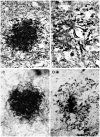Historic evidence to support a causal relationship between spirochetal infections and Alzheimer's disease
- PMID: 25932012
- PMCID: PMC4399390
- DOI: 10.3389/fnagi.2015.00046
Historic evidence to support a causal relationship between spirochetal infections and Alzheimer's disease
Abstract
Following previous observations a statistically significant association between various types of spirochetes and Alzheimer's disease (AD) fulfilled Hill's criteria in favor of a causal relationship. If spirochetal infections can indeed cause AD, the pathological and biological hallmarks of AD should also occur in syphilitic dementia. To answer this question, observations and illustrations on the detection of spirochetes in the atrophic form of general paresis, which is known to be associated with slowly progressive dementia, were reviewed and compared with the characteristic pathology of AD. Historic observations and illustrations published in the first half of the 20th Century indeed confirm that the pathological hallmarks, which define AD, are also present in syphilitic dementia. Cortical spirochetal colonies are made up by innumerable tightly spiraled Treponema pallidum spirochetes, which are morphologically indistinguishable from senile plaques, using conventional light microscopy. Local brain amyloidosis also occurs in general paresis and, as in AD, corresponds to amyloid beta. These historic observations enable us to conclude that chronic spirochetal infections can cause dementia and reproduce the defining hallmarks of AD. They represent further evidence in support a causal relationship between various spirochetal infections and AD. They also indicate that local invasion of the brain by these helically shaped bacteria reproduce the filamentous pathology characteristic of AD. Chronic infection by spirochetes, and co-infection with other bacteria and viruses should be included in our current view on the etiology of AD. Prompt action is needed as AD might be prevented.
Keywords: Alzheimer’s disease; Borrelia burgdorferi; Treponema pallidum; Treponema spirochetes; dementia; general paresis; oral spirochetes; syphilis.
Figures





Similar articles
-
Bacterial Amyloid and DNA are Important Constituents of Senile Plaques: Further Evidence of the Spirochetal and Biofilm Nature of Senile Plaques.J Alzheimers Dis. 2016 Jun 13;53(4):1459-73. doi: 10.3233/JAD-160451. J Alzheimers Dis. 2016. PMID: 27314530 Free PMC article.
-
Alzheimer's disease - a neurospirochetosis. Analysis of the evidence following Koch's and Hill's criteria.J Neuroinflammation. 2011 Aug 4;8:90. doi: 10.1186/1742-2094-8-90. J Neuroinflammation. 2011. PMID: 21816039 Free PMC article. Review.
-
Chronic inflammation and amyloidogenesis in Alzheimer's disease -- role of Spirochetes.J Alzheimers Dis. 2008 May;13(4):381-91. doi: 10.3233/jad-2008-13404. J Alzheimers Dis. 2008. PMID: 18487847 Review.
-
An Association of Pathogens and Biofilms with Alzheimer's Disease.Microorganisms. 2021 Dec 28;10(1):56. doi: 10.3390/microorganisms10010056. Microorganisms. 2021. PMID: 35056505 Free PMC article. Review.
-
Borrelia burgdorferi persists in the brain in chronic lyme neuroborreliosis and may be associated with Alzheimer disease.J Alzheimers Dis. 2004 Dec;6(6):639-49; discussion 673-81. doi: 10.3233/jad-2004-6608. J Alzheimers Dis. 2004. PMID: 15665404
Cited by
-
Bacterial Amyloid and DNA are Important Constituents of Senile Plaques: Further Evidence of the Spirochetal and Biofilm Nature of Senile Plaques.J Alzheimers Dis. 2016 Jun 13;53(4):1459-73. doi: 10.3233/JAD-160451. J Alzheimers Dis. 2016. PMID: 27314530 Free PMC article.
-
The Possibility of an Infectious Etiology of Alzheimer Disease.Mol Neurobiol. 2019 Jun;56(6):4479-4491. doi: 10.1007/s12035-018-1388-y. Epub 2018 Oct 18. Mol Neurobiol. 2019. PMID: 30338482 Review.
-
Lipopolysaccharide, Identified Using an Antibody and by PAS Staining, Is Associated With Corpora amylacea and White Matter Injury in Alzheimer's Disease and Aging Brain.Front Aging Neurosci. 2021 Nov 24;13:705594. doi: 10.3389/fnagi.2021.705594. eCollection 2021. Front Aging Neurosci. 2021. PMID: 34899263 Free PMC article.
-
Assessing the role of Porphyromonas gingivalis in periodontitis to determine a causative relationship with Alzheimer's disease.J Oral Microbiol. 2019 Jan 29;11(1):1563405. doi: 10.1080/20002297.2018.1563405. eCollection 2019. J Oral Microbiol. 2019. PMID: 30728914 Free PMC article. Review.
-
Rhesus Brain Transcriptomic Landscape in an ex vivo Model of the Interaction of Live Borrelia Burgdorferi With Frontal Cortex Tissue Explants.Front Neurosci. 2019 Jun 28;13:651. doi: 10.3389/fnins.2019.00651. eCollection 2019. Front Neurosci. 2019. PMID: 31316336 Free PMC article.
References
-
- Aars C. G. (1930). Paralytic dementia. The localization of spirochaeta pallida in the brain. Arch. Neurol. Psychiatr. 23, 512–520 10.1001/archneurpsyc.1930.02220090103006 - DOI
-
- Achúcarro A. (1909). The standpoint of histopathology in the study of mental diseases. Bull. N1. Govt. Hosp. Insane Washington 35, 43–54.
-
- Alzheimer A. (1897). Über klinisch und histologisch eigenartige psychische Erkrankungen des späteren Lebensalters. Nissl’s Arbeiten 4, 297–358.
-
- Alzheimer A. (1898). Neuere arbeiten über die dementia senilis und die auf atheromatöser gefässerkrankung hasiereden gehirnkrankheiten. Eur. Neurol. 3, 101–115 10.1159/000228782 - DOI
-
- Alzheimer A. (1907). Über eine eigenartige erkrankung der hirnrinde. Z. Psych. Gerich. Med. 64, 146–148 (English translation in The early story of Alzheimer’s disease, 1–3, by Bick K. L., Amaducci L., Pepeu G. Eds., 1987, Padova: Liviana Press; ).
Publication types
LinkOut - more resources
Full Text Sources
Other Literature Sources

